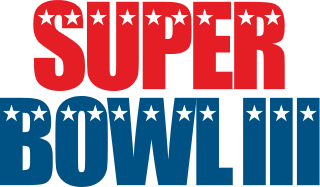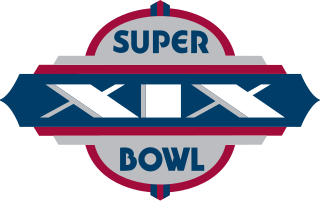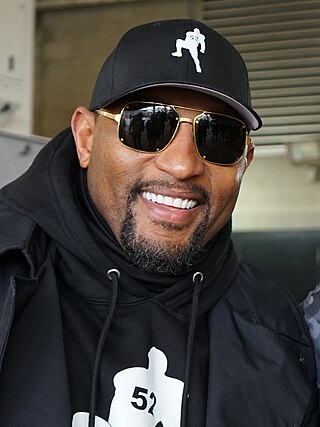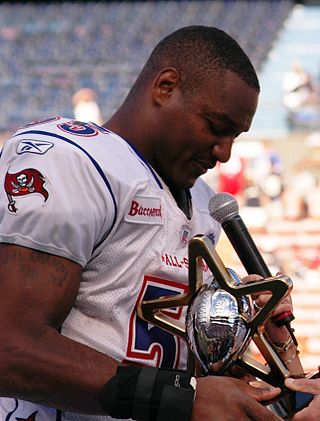
Super Bowl III was an American football game played on January 12, 1969, at the Orange Bowl in Miami, Florida. It was the third AFL–NFL Championship Game in professional American football, and the first to officially bear the trademark name "Super Bowl". Super Bowl III is regarded as one of the greatest upsets in both American football history and in the history of professional sports. The 19 1⁄2- points underdog American Football League (AFL) champion New York Jets defeated the National Football League (NFL) champion Baltimore Colts by a score of 16–7.

Super Bowl XX was an American football game between the National Football Conference (NFC) champion Chicago Bears and the American Football Conference (AFC) champion New England Patriots to decide the National Football League (NFL) champion for the 1985 season. The Bears defeated the Patriots by the score of 46–10, capturing their first NFL championship since 1963, three years prior to the birth of the Super Bowl. Super Bowl XX was played on January 26, 1986, at the Louisiana Superdome in New Orleans.
Super Bowl VIII was an American football game between the National Football Conference (NFC) champion Minnesota Vikings and the American Football Conference (AFC) champion Miami Dolphins to decide the National Football League (NFL) champion for the 1973 season. The Dolphins conquered the Vikings by the score of 24–7 to win their second consecutive Super Bowl, the first team to do so since the Green Bay Packers in Super Bowls I and II, and the first AFL/AFC team to do so.

Super Bowl IX was an American football game played between the American Football Conference (AFC) champion Pittsburgh Steelers and the National Football Conference (NFC) champion Minnesota Vikings to decide the National Football League (NFL) champion for the 1974 season. The game was played on January 12, 1975, at Tulane Stadium in New Orleans, Louisiana. The Steelers defeated the Vikings by the score of 16–6 to win their first Super Bowl championship.

Super Bowl XV was an American football game between the American Football Conference (AFC) champion Oakland Raiders and the National Football Conference (NFC) champion Philadelphia Eagles to decide the National Football League (NFL) champion for the 1980 season. The Raiders defeated the Eagles by the score of 27–10, becoming the first wild card playoff team to win a Super Bowl.

Super Bowl XVIII was an American football game played on January 22, 1984, at Tampa Stadium between the National Football Conference (NFC) champion and defending Super Bowl XVII champion Washington Redskins and the American Football Conference (AFC) champion Los Angeles Raiders to determine the National Football League (NFL) champion for the 1983 season. The Raiders defeated the Redskins, 38–9. The Raiders' 38 points scored and 29-point margin of victory broke Super Bowl records; it remains the most points scored by an AFC team in a Super Bowl, later matched by the Kansas City Chiefs in Super Bowl LVII. This is the first time the city of Tampa hosted the Super Bowl and was the AFC's last Super Bowl win until Super Bowl XXXII, won by the Denver Broncos.

Super Bowl XIX was an American football game between the American Football Conference (AFC) champion Miami Dolphins and the National Football Conference (NFC) champion San Francisco 49ers to decide the National Football League (NFL) champion for the 1984 season. The 49ers defeated the Dolphins by the score of 38–16, to win their second Super Bowl. The game was played on January 20, 1985, at Stanford Stadium, on the campus of Stanford University in Stanford, California, the first Super Bowl played in the San Francisco Bay Area. This also became the second Super Bowl after Super Bowl XIV where the game was coincidentally played in the home market of one of the participants.

Super Bowl XXXV was an American football game between the American Football Conference (AFC) champion Baltimore Ravens and the National Football Conference (NFC) champion New York Giants to decide the National Football League (NFL) champion for the 2000 season. The Ravens defeated the Giants by a score of 34–7, tied for the seventh largest Super Bowl margin of victory with Super Bowl XXXVII. The game was played on January 28, 2001, at Raymond James Stadium in Tampa, Florida, making it the first time Raymond James Stadium has held a Super Bowl.

Raymond Anthony Lewis Jr. is a former American football linebacker who played his entire 17-year career for the Baltimore Ravens of the National Football League (NFL). He played college football for the Miami Hurricanes, where he earned All-America honors.

Julius Frazier Peppers is an American former professional football player who was a defensive end and linebacker in the National Football League (NFL). He played college football for the North Carolina Tar Heels, where he was recognized as a unanimous All-American, and was selected by the Carolina Panthers second overall in the 2002 NFL draft, and also played for the Chicago Bears from 2010 through 2013 and the Green Bay Packers from 2014 to 2016. After rejoining the Panthers for the 2017 season, he retired after the 2018 NFL season.

Tedy Lacap Bruschi is an American former professional football player who was a linebacker in the National Football League (NFL) for 13 seasons, who is the senior advisor to the head coach at University of Arizona. He played college football for the University of Arizona, and was a two-time consensus All-American. He was drafted by the New England Patriots in the third round of the 1996 NFL Draft, and played his entire professional career with the Patriots. Bruschi won three Super Bowls and was a two-time second-team All-Pro selection.

Rodney Scott Harrison is an American former football safety who played in the National Football League (NFL) for 15 seasons with the San Diego Chargers and New England Patriots. He was selected in the fifth round of the 1994 NFL Draft by the Chargers, where he spent his first nine seasons, and was a member of the Patriots in his following six. Since leaving the NFL in 2009, he has served as a commentator for NBC's Football Night in America.

Derrick Dewan Brooks is an American former professional football player who was a linebacker for his entire 14-year career in the National Football League (NFL) with the Tampa Bay Buccaneers. Brooks played college football for the Florida State Seminoles, earning consensus All-American honors twice. He was selected by the Buccaneers in the first round of the 1995 NFL Draft. An 11-time Pro Bowl selection and five-time first-team All-Pro, Brooks was the NFL Defensive Player of the Year in 2002 en route to winning the franchise's first Super Bowl title in Super Bowl XXXVII. Following his retirement, Brooks served as co-owner and president of the Tampa Bay Storm in the Arena Football League (AFL) from 2011 to 2017. He was inducted to the Pro Football Hall of Fame in 2014 and the College Football Hall of Fame in 2016.

Zachary Michael Thomas is an American former professional football player who was a linebacker in the National Football League (NFL) for 13 seasons. He played college football for the Texas Tech Red Raiders, and was recognized as a unanimous All-American. He was selected in the fifth round, 22nd pick, in the 1996 NFL Draft by the Miami Dolphins, and played for the Dolphins in his first 12 seasons in the NFL, before playing his 13th and final season with the Dallas Cowboys.

Randy Charles Gradishar is an American former professional football player who was a linebacker in the 1970s and 1980s for the Denver Broncos of the National Football League (NFL). A native of Ohio, Gradishar was a one-time consensus and one-time unanimous All-American for the Ohio State Buckeyes, before playing ten seasons for Denver, where he was the centerpiece of their "Orange Crush Defense". In 2024, he was inducted into the Pro Football Hall of Fame.

Darrin Andrew Smith is an American former professional football player who was a linebacker in the National Football League (NFL) for the Dallas Cowboys, Philadelphia Eagles, Seattle Seahawks and New Orleans Saints. He played college football for the Miami Hurricanes.
Quentin John Coryatt is a former American football linebacker in the National Football League (NFL) for the Indianapolis Colts and Dallas Cowboys. He played college football at Texas A&M University. He is distinguished as being the first Crucian to play in the NFL.
Daniel Joseph Conners was an American professional football linebacker who played 11 seasons for the Oakland Raiders of the American Football League (AFL) from 1964 through 1969, and later in the National Football League (NFL) from 1970 through 1974. He played college football for the Miami Hurricanes and is enshrined in their Hall of Fame.

Erik Lashawn Walden is a former American football linebacker. He played college football at Middle Tennessee State and was drafted by the Dallas Cowboys in the sixth round of the 2008 NFL Draft. He also played for the Kansas City Chiefs, Miami Dolphins, Green Bay Packers, Indianapolis Colts, Tennessee Titans, and Seattle Seahawks. With the Packers, he won Super Bowl XLV in 2010.

Bruce Pernell Irvin Jr. is an American football linebacker for the Miami Dolphins of the National Football League (NFL). He was selected by the Seattle Seahawks in the first round with the 15th overall pick of the 2012 NFL Draft. Irvin won Super Bowl XLVIII over the Denver Broncos, and also played in Super Bowl XLIX where he became the first player ever to be ejected from a Super Bowl. He played college football at West Virginia.

















